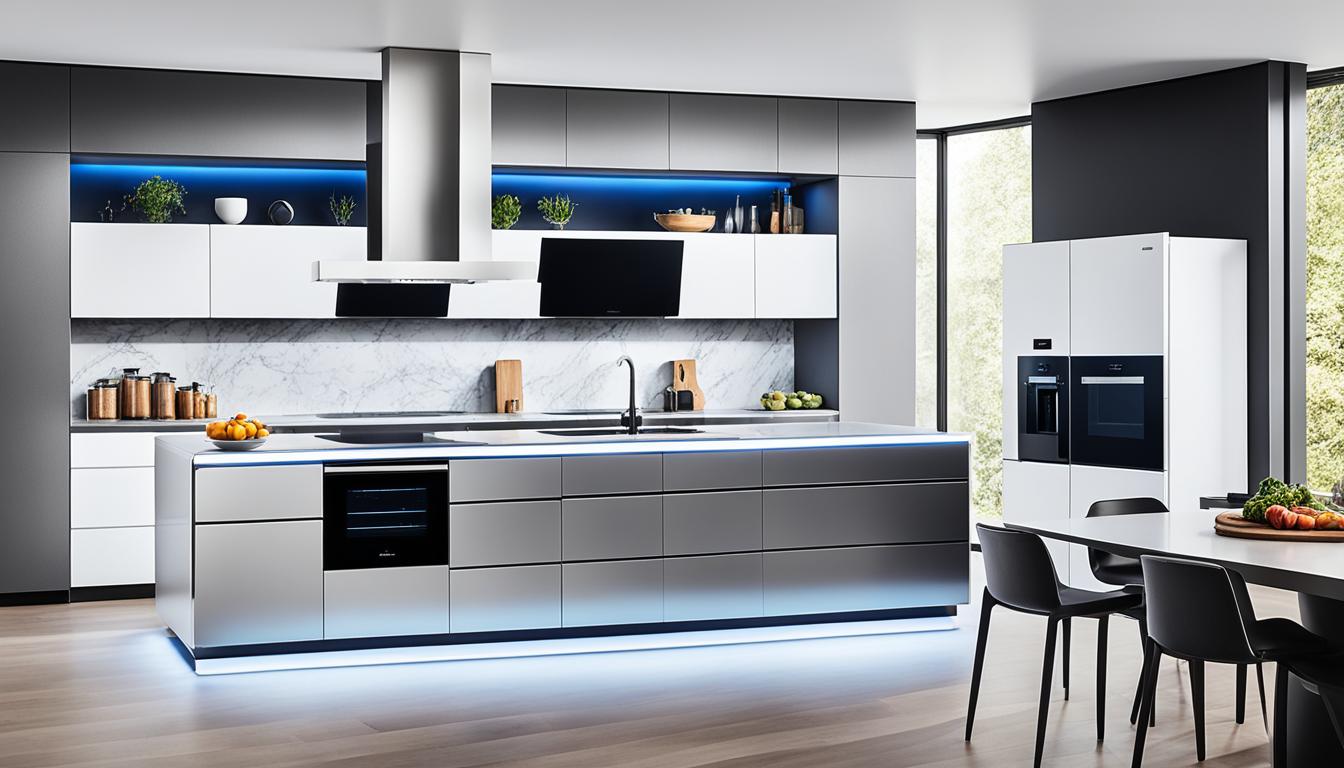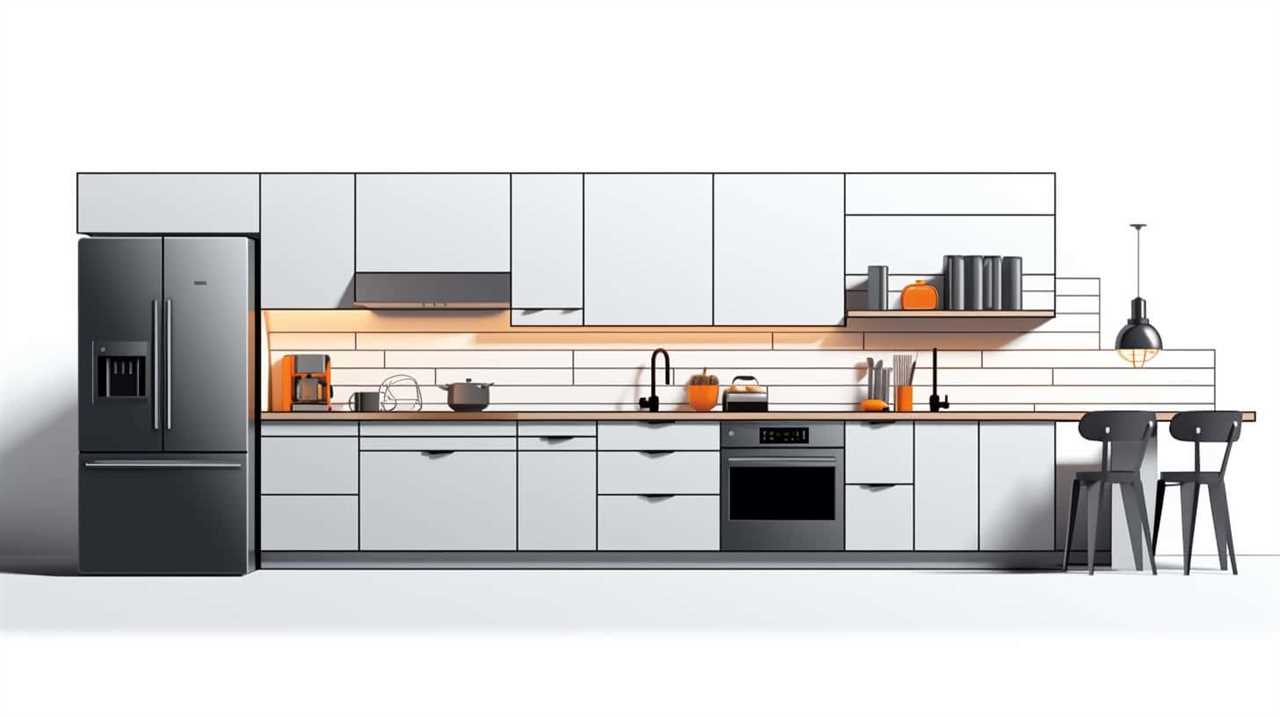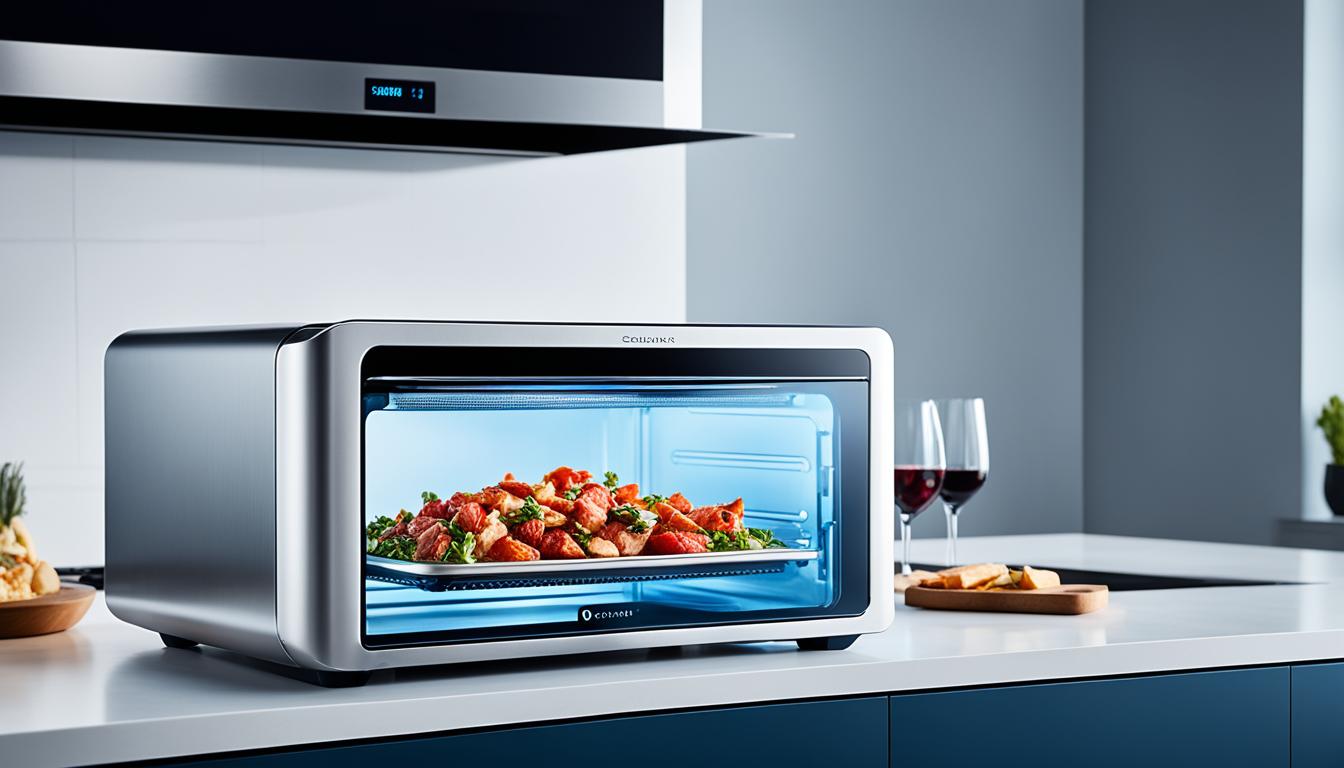Did you realize that the global smart home market is projected to reach $174 billion by 2025? Advancements in technology are constantly improving, leading to a growing demand for smart devices in households. Kitchens, in particular, can greatly benefit from these innovative gadgets.
Turning your kitchen into a smart space can change how you cook and eat. Think about telling your appliances what to do with just your voice. Or getting ideas for dinner based on what’s in your fridge. With the best smart gadgets, your kitchen can be both cool and smart.
- Discover the top smart home ecosystems for your kitchen
- Understand the importance of a reliable Wi-Fi connection
- Choose the right connection method for your smart devices
- Ensure seamless integration with your chosen ecosystem
- Learn how to set up and control your smart devices with ease
Are you a pro chef or just love being in the kitchen? This guide will show you how to make a smart kitchen. It will make cooking fun and your daily tasks easier.
Key Takeaways:
- Smart home devices can make your kitchen better and more fun.
- Picking the right smart home system is key for it to work well.
- Good Wi-Fi is a must for smart gadgets to work together smoothly.
- Think about how your devices will connect (Bluetooth, Wi-Fi, smart hubs) for the best results.
- Make sure your devices will work with your smart home system before you buy.
Pick Your Ecosystem: Google Home, Amazon Alexa, or Apple HomeKit?
Before shopping for smart home devices, choose an ecosystem. The main options are Google Home, Amazon Alexa, and Apple HomeKit. Each has strengths and works with different devices. We’ll explore each to help you choose wisely.
Think about what devices you own when choosing. If you own Apple products, HomeKit might fit you best. For Google users, Google Home is a good choice. Amazon fans might prefer Alexa.
Let’s look more closely at each ecosystem:
Google Home
Google Home features smart speakers and displays. They use Google Assistant. Use your voice to control devices, play music, and get answers. Google Home meshes with Google services, aiding your daily routine.
Amazon Alexa
Amazon Echo devices use Alexa. She helps control devices, play music, and order from Amazon. Amazon’s ecosystem supports many devices, making home expansion easy.
Apple HomeKit
HomeKit is for Apple users, working with Siri. Control devices by voice or with the Home app. It’s secure and partners well with Apple’s offerings.
“Choosing the right ecosystem is crucial for creating a seamless smart home experience. Consider your existing devices, preferences, and the specific features offered by each ecosystem to make an informed decision.”
Now, you know the three main ecosystems. Take time to look into features, device compatibility, and reviews. Feel free to mix devices from different ecosystems as needed. Aim for a convenient and lifestyle-enhancing smart home.
We’ll next touch on Wi-Fi’s role in smart homes. We’ll cover getting a stable connection for the best device performance.
The Importance of Wi-Fi for Smart Home Devices
A reliable Wi-Fi connection is a must for smart home devices to work well. Most gadgets use either the 2.4 GHz or 5 GHz frequency bands. The 2.4 GHz is more often used. It’s key to find a good place for your router. Think about issues like congestion and the router’s limits too.
For your smart home, your Wi-Fi should reach everywhere you’ll use devices. Thick walls or different floors can affect your Wi-Fi signal. If needed, you might use Wi-Fi extenders or mesh systems to cover all areas.
The Wi-Fi 6E protocol is the new kid on the block. It brings faster speeds and handles devices better. But, it’s still new to the scene. If you’re planning for the future, get routers and devices that support Wi-Fi 6E.
A reliable Wi-Fi connection is the backbone of a smart home. Without it, you can face delays or disconnections. It’s like having a car but no gas, or a house yet no electricity.” – Smart Home Enthusiast
Always secure your Wi-Fi with a strong password to keep out uninvited guests. Also, update your router’s software regularly. This helps with speed and security.
Wi-Fi Tips for Optimizing Your Smart Home Experience:
- Place your router in a central location to ensure maximum coverage.
- Minimize signal interference by keeping your router away from appliances, metal objects, and dense walls.
- Consider using a Wi-Fi analyzer app to identify Wi-Fi dead zones in your home.
- Upgrade to a higher-speed internet plan if you have multiple devices connected simultaneously.
- Create a separate guest network to protect your main network from potential security risks.
Make your Wi-Fi strong and reliable for a better smart home. This ensures your devices talk smoothly with each other. And it makes your smart home better.
Bluetooth, Wi-Fi, or Smart Hubs: Choosing the Right Connection
There are a few ways to connect your smart home gadgets: Bluetooth, Wi-Fi, or smart hubs. Each way of connecting has good and bad points. So it’s key to pick what works best for you.
Bluetooth
Choosing Bluetooth is smart if you want something easy and cheap. It lets your gadgets talk with each other without needing a central hub or internet. This is good for small setups or when things are near each other.
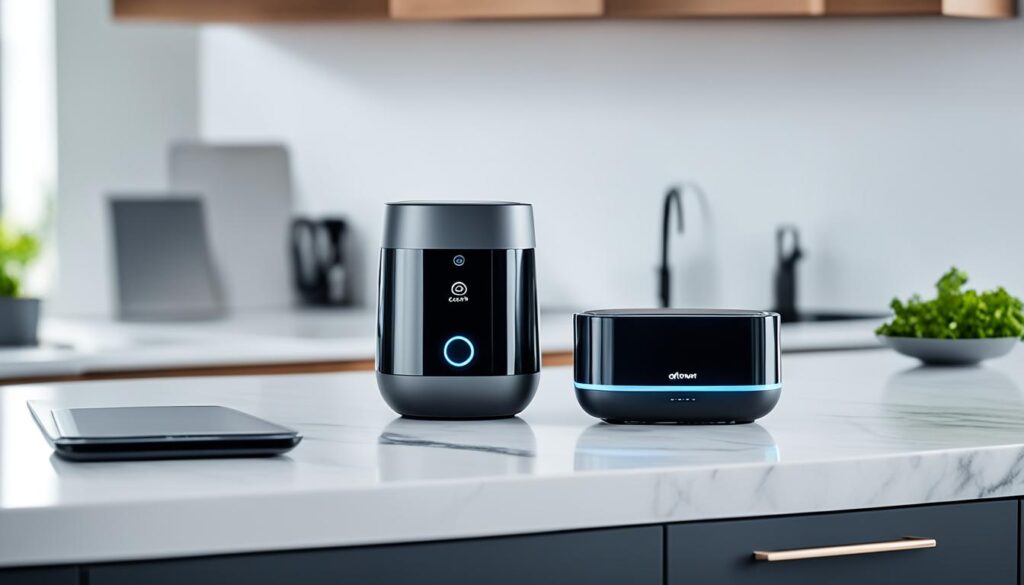
Bluetooth isn’t as fast as Wi-Fi, but it’s still good for simple commands. Remember, Bluetooth’s reach is about 30 feet. So, for devices far apart in your home, think about using Wi-Fi or a hub instead.
Wi-Fi
Wi-Fi is a popular and flexible way to connect your smart home devices. It lets you link many gadgets at once. You can control them from anywhere if you have internet. Wi-Fi is quicker than Bluetooth. This is great for gadgets that need quick answers, like security cams or smart thermostats.
But, having lots of devices on Wi-Fi can slow things down. This might cause slow speeds or trouble connecting. To prevent this, put your router in a central spot. Keep it away from things that can block the signal. Also, consider a router that can handle many devices well, using MU-MIMO technology.
Smart Hubs
For a complex setup with gadgets from different brands, a smart hub can make things easier. Smart hubs bring everything together. You manage all your gadgets from one app. They often work with both Bluetooth and Wi-Fi. This gives you more options.
Smart hubs can also help with too many devices slowing down your Wi-Fi. They deal with gadget communication internally. This can make connections more stable and reliable, especially in big homes or with many smart devices.
The decision between Bluetooth, Wi-Fi, or smart hubs depends on your setup’s needs. Think about range, speed, compatibility, and how easy it is to use when choosing. Picking the right way to connect helps your smart home work smoothly.
Verify Smart-Home Support for Seamless Integration
Before buying a smart home device, make sure it fits with your system. You want all your gadgets to work well together. This makes for a connected, easy smart home.
To check smart-home support, look for logos like “Works with Google Assistant,” “Works with Alexa,” or “Works with Apple HomeKit.” These mean the device will work well with that system. Picking devices with proper support helps avoid problems.
But, it’s key to see more than just if it connects. Each gadget may work differently with your system. Some offer more features and better integration than others.
Checking Device-Specific Features and Capabilities
When checking smart-home support, look into what each gadget can do. Some may just do basic tasks. Others can do more, like automated actions or special features.
For instance, with a smart thermostat, see if it can set heating and cooling patterns. Or, for smart lights, check if they change colors or dim. These features can make your smart home better.
This deeper integration matters. It makes your smart home more helpful and fun. You get more control and convenience.
“Finding devices that fit well with your system is crucial for a great smart home.” – Smart Home Enthusiast
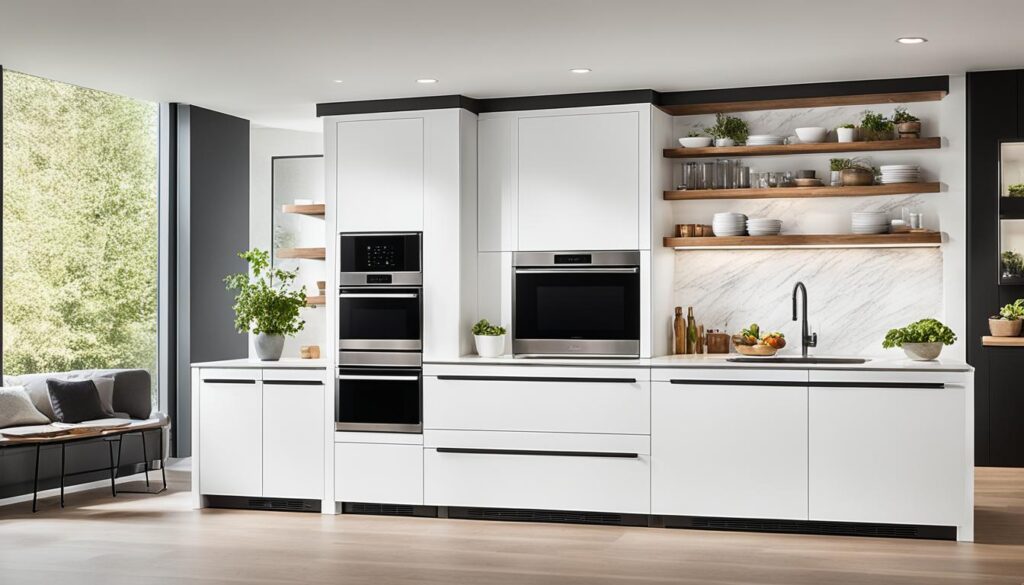
By making sure of smart-home support and looking at what each device can do, you can create a great smart home. Everything works smoothly together. It makes your home more functional and easy to manage.
Next, we will talk about setting up your smart-home gadgets for easy use. This makes for a smart home that’s truly yours and very efficient.
Setting Up Smart-Home Devices for Easy Control
Once you pick your ecosystem and check compatibility, it’s time to set up your devices. We will guide you in making control simple and convenient.
Find the Perfect Spot for Your Devices
When you set up your devices, think about where they should go. Put smart speakers or displays in the center for better reach. Place thermostats, sensors, or cameras smartly for the best use.
For instance, a smart thermostat works best in a spot away from the sun and drafts. Smart cameras at entry points improve home security.
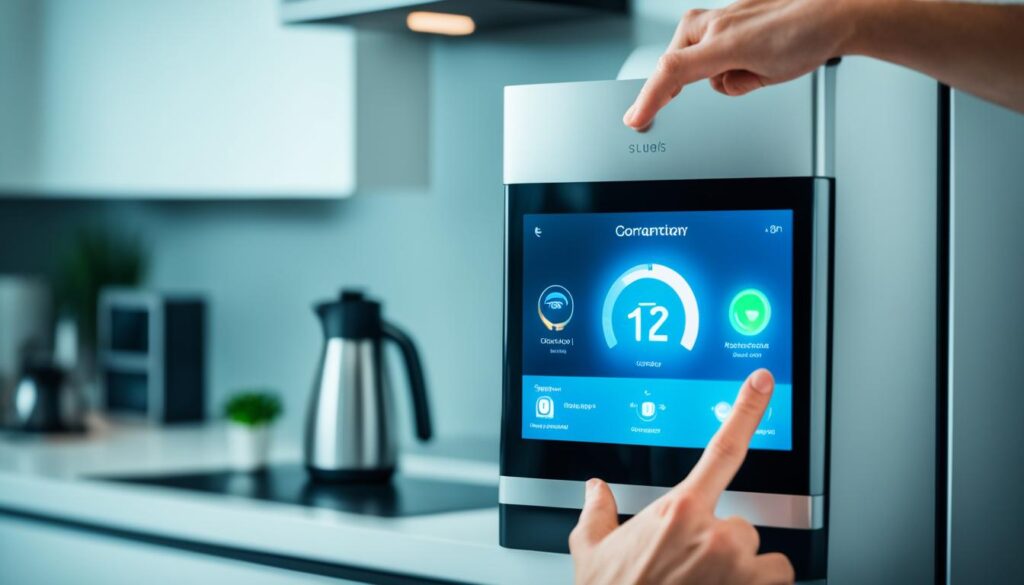
Choose Names for Easy Voice Control
It’s smart to pick names for your devices that are easy to say and remember. This matters a lot for voice command control. Avoid names that sound alike to prevent mix-ups.
For instance, name smart lights as “Kitchen Light,” “Living Room Light,” and “Bedroom Light” for easy control.
Group Devices and Create Automation
Smart homes let you group devices for one-command control. Say, a “Living Room” group could include your smart TV, lights, and blinds. Saying “Turn on the Living Room” would activate everything at once.
Automations add more ease by setting schedules or responding to events. Like turning lights and heat on when you get home. Or, turning all devices off as you leave.
Pro Tip: Automations save time and spruce up your smart home.
Customize Routines for Seamless Control
Routines adjust your devices to fit your life and likes. They can work with voice commands or certain events. You might have a “Good Morning” routine that turns on lights, starts coffee, and plays music with just those two words.
Setting routines personalizes your smart home to match your daily life, boosting comfort and ease.
| Benefits of Setting Up Smart-Home Devices for Easy Control |
|---|
| Enhanced accessibility and convenience |
| Streamlined control of multiple devices |
| Customized routines for personalized experiences |
| Time-saving automation of daily tasks |
| Effortless management of your smart home setup |
By following these tips and using the tools of your chosen ecosystem, you can make controlling your smart home easy. Enjoy a smooth and convenient smart home experience.
What to Do When You Move or Change Routers
When you get a new place or want a better internet setup, think about your smart devices. This guide will tell you how to keep them working well. You won’t have any problems.
1. Follow the Manufacturer’s Instructions
Look at the manual for each smart device first. They all have their own way to reset and reconnect. Following these steps makes sure they disconnect properly and connect to the new network.
2. Review and Update Your Smart Home Setup
Changing your router is a chance to check your smart home setup. Think about where your devices are and how they work. Maybe add new devices or drop some. Look out for new features too.
Also, make sure your smart home is safe. Update passwords and use two-factor authentication if you can. Look for device updates too.
3. Reconnect Devices to the New Network
After resetting your devices and checking your setup, connect them to the new network. Use the smart app for each device and follow the steps on the screen. Be sure to use the right Wi-Fi details.
You might want to rename devices or put them in groups. This makes using voice commands or the app easier.
4. Test and Troubleshoot
Check your devices after you connect them again. Make sure they follow commands and everything works right. Look for any connectivity or performance problems.
If you have issues, look at the troubleshooting guide or call the manufacturer’s help team. They can tell you what to do to fix any problems.
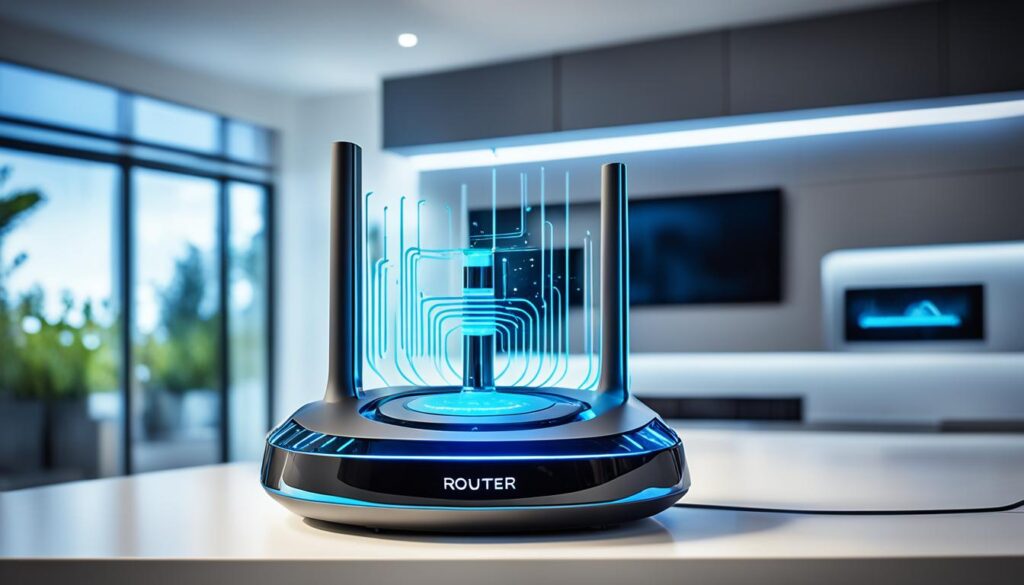
Follow these steps for an easy time with your smart home devices when you move or switch routers. You’ll keep your devices working great. You’ll also have a chance to make your smart home even better for your new place.
A Word on Security: Protecting Your Smart Home
Smart home security is key for your privacy and safety. You can prevent unwanted access by using the right security steps. Enjoy your smart home safely by doing this.
Choose a Strong and Secure Wi-Fi Password
Start by choosing a strong Wi-Fi password. It should be long, complex, and not easily guessed. Avoid common passwords or personal info that others can guess.
Consider a Separate Network for Smart Home Devices
Think about making a separate network for your smart devices. This keeps them safe from other devices on your main network. Check your router’s manual or ask your internet provider how to do this.
Set Up a Guest Network
If you have guests often, set up a guest network. It gives them internet without risking your main network’s security. Many routers let you make a guest network easily.
Mindful Data Collection Practices
Know about the data collection of your smart devices. Read their privacy policies to understand what data they collect. This helps you make smart choices about what devices you use and the data you share.
Maximizing Smart Home Security
To better protect your smart home, take more steps. Update your devices regularly for security. Use two-factor authentication to stop unwanted access. Also, buying a good smart home security system can help a lot.

| Smart Home Security Practices | Benefits |
|---|---|
| Choosing a strong Wi-Fi password | Prevents unauthorized access to your network |
| Setting up a separate network for smart home devices | Isolates your devices for added security |
| Creating a guest network | Offers secure internet access for guests |
| Mindful data collection practices | Ensures privacy and control over shared data |
| Regularly updating firmware and software | Maintains security with the latest patches |
| Enabling two-factor authentication | Provides an additional layer of defense |
| Investing in a smart home security system | Comprehensive protection and monitoring |
Troubleshooting Tips for Common Smart Home Issues
Smart home devices are handy, but they can have problems. You might face issues with connections, device compatibility, or software bugs. These tips will help fix them and keep your smart home running smoothly.
1. Connectivity Issues
Connectivity problems are common in smart homes. If your Wi-Fi or Bluetooth is not working well, try these steps:
- Ensure your smart home devices are within range of your Wi-Fi router or hub.
- Check for any obstructions that may be blocking the signals, such as walls or furniture.
- Reset your router or hub and reconnect your devices.
- Consider adding a Wi-Fi extender or mesh network system to improve signal coverage.
2. Device Compatibility
It can be tricky to get smart home devices to work together. If you’re having trouble, try these tips:
- Check the compatibility requirements of each device, including the required operating system or firmware.
- Ensure that all devices are connected to the same ecosystem or hub.
- Update the firmware or software of your devices to ensure compatibility with the latest standards.
- If all else fails, consider using third-party integrations or hubs to bridge the compatibility gap.
3. Software Glitches
Software glitches might make your devices act up. Here are some steps to fix these problems:
- Restart the affected device and check for any available software updates.
- Reset the device to its factory settings and reconfigure it from scratch.
- Contact the manufacturer’s support team or consult online forums for specific troubleshooting steps.
- Consider using third-party apps or platforms to control your devices if the native software is causing issues.
Pro Tip: To avoid many common issues, keep your devices updated with the latest firmware or software.
Follow these tips and make the necessary fixes to solve smart home issues. This will help you enjoy a seamlessly running smart home.
Troubleshooting Quick Reference
| Issue | Troubleshooting Tip |
|---|---|
| Connectivity Problems | Ensure devices are within range of the router or hub, check for obstructions, reset the router, consider signal boosters. |
| Device Compatibility | Check compatibility requirements, connect devices to the same ecosystem, update firmware/software, use third-party integrations or hubs. |
| Software Glitches | Restart devices, check for software updates, reset to factory settings, seek manufacturer support, use third-party apps/platforms. |
Refer to the table above for a quick reference of troubleshooting tips for common smart home issues.
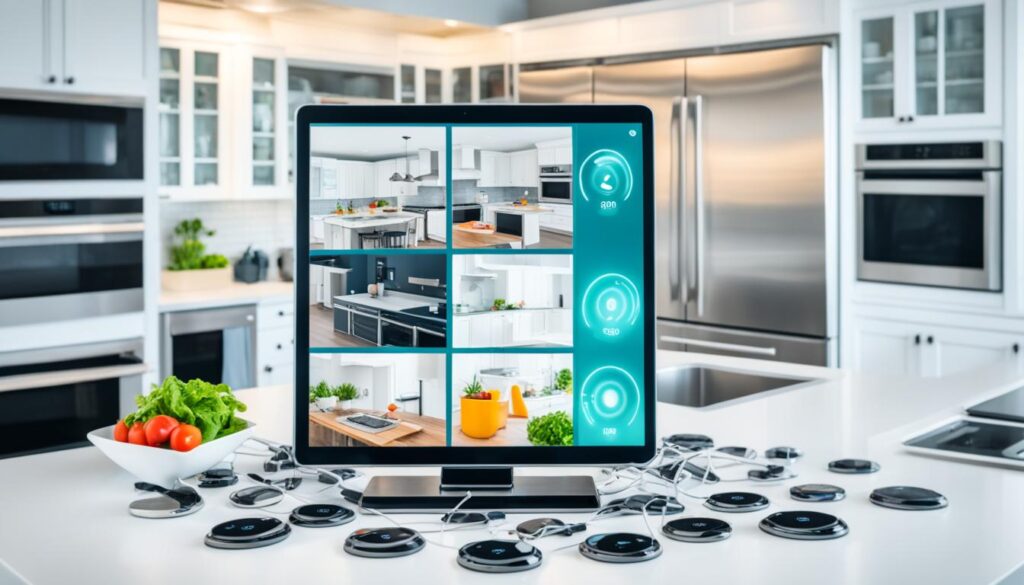
Smart Home Gadgets for a Cozy Living Room
The living room is a key part of any home. Smart gadgets make it more comfy and handy. With them, you can make your living room both cozy and modern.
Smart Speakers
Smart speakers are great for any living room. You can play music, hear podcasts, and control devices by just talking. Some top picks are the Amazon Echo with Alexa, Google Nest Audio with Google Assistant, and Apple HomePod with Siri.
Smart Displays
Smart displays can level up your living room. They work like speakers but have screens. Use them to watch videos, call friends, or show photos. Favorites include the Amazon Echo Show, Google Nest Hub, and Facebook Portal.
Smart Lighting
Smart lighting lets you create the perfect vibe. You can change brightness and colors. Voice or phone control is possible. Try Philips Hue and LIFX for cool effects.
Smart Televisions
Upgrade to a smart TV for better entertainment. They come with streaming apps and voice control. Top brands are Samsung, LG, and Sony.
Smart Thermostats
Smart thermostats keep your room comfy and save energy. Control them from anywhere. The Nest Learning Thermostat and Ecobee SmartThermostat are good for cutting costs.
Smart Home Hubs
A smart home hub can manage all your gadgets. It makes automation easy. Check out the Samsung SmartThings Hub, Amazon Echo Plus, and Hubitat Elevation.
Entertainment Systems
Smart systems can boost your living room’s audio and video. Try soundbars like the Sonos Beam and Bose SoundTouch 300. For awesome sound, look at the Yamaha YHT-4950U.
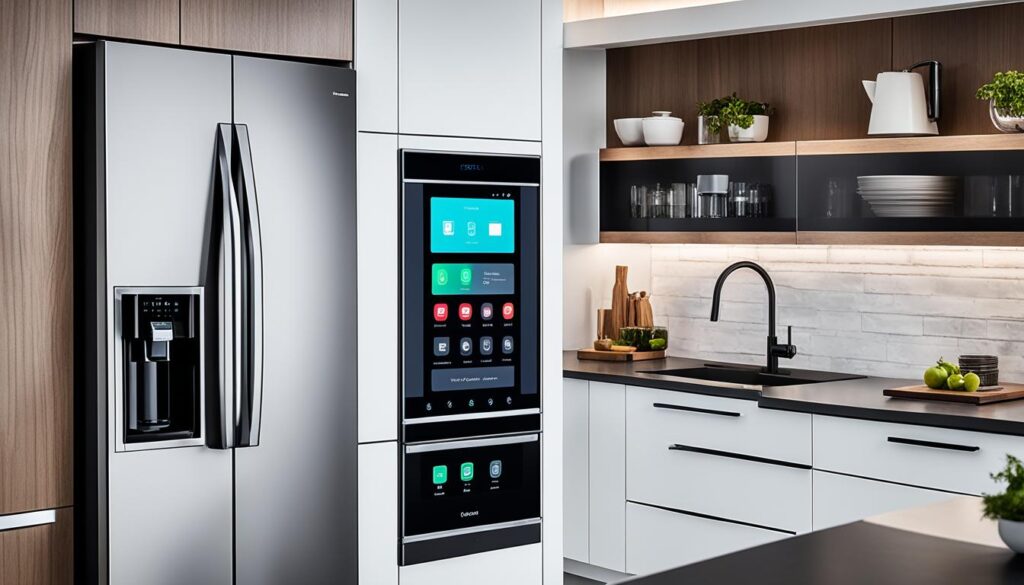
These smart gadgets can make your living room better. You can control devices, set lighting, and adjust temperature easily. Get these gadgets for a comfy and modern living room.
Conclusion
Creating a smart kitchen improves your cooking experience. It makes everything more efficient and connected. Use essential gadgets and pick a compatible system for best results.
To pick your system, you might choose Google Home, Amazon Alexa, or Apple HomeKit. Each lets you control your kitchen easily. A strong Wi-Fi is also crucial for your gadgets to work well. Wi-Fi 6E can give you even faster speeds.
After picking your ecosystem and setting up Wi-Fi, place your devices smartly. Name them well for easy voice commands. Group them and use automation to boost your kitchen’s convenience.
Don’t forget about security to keep your smart kitchen safe. Use a strong Wi-Fi password and a separate network for devices. Be aware of how your system uses your info. Fix any problems quickly for a great experience.
